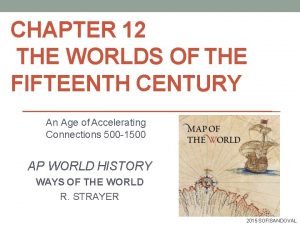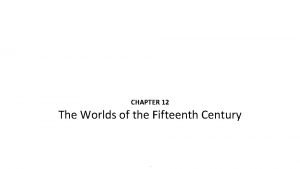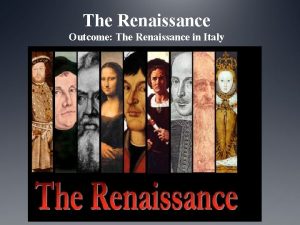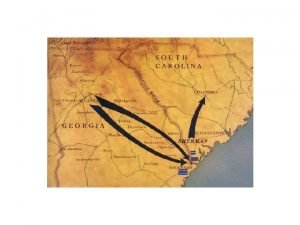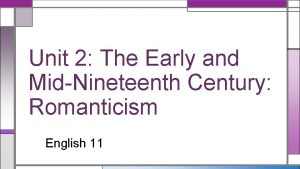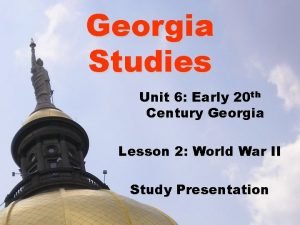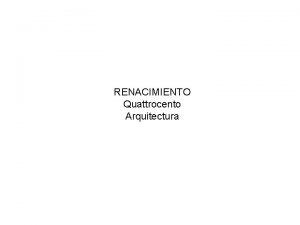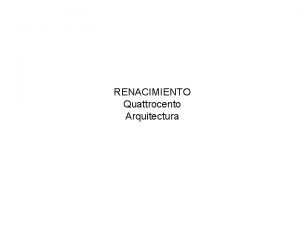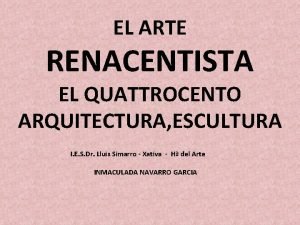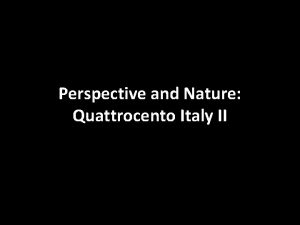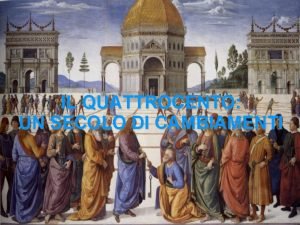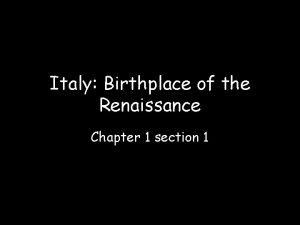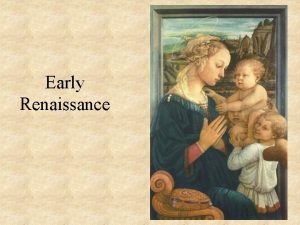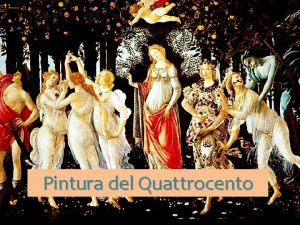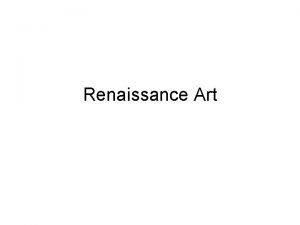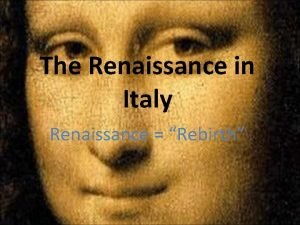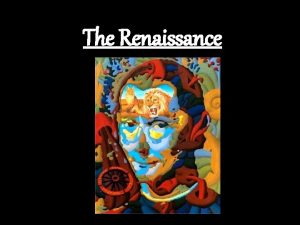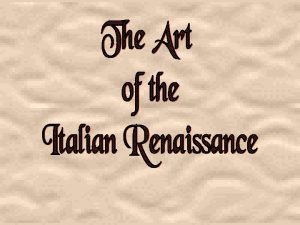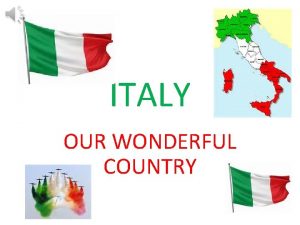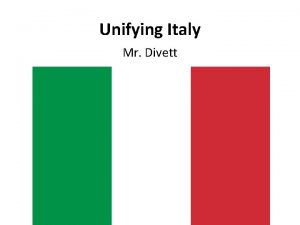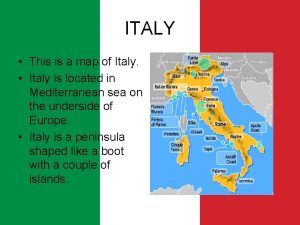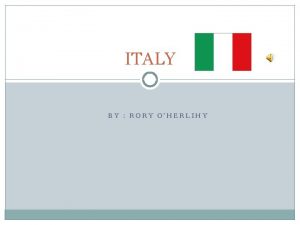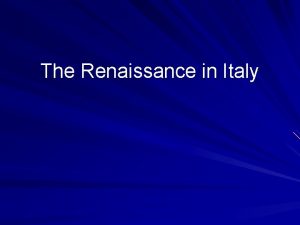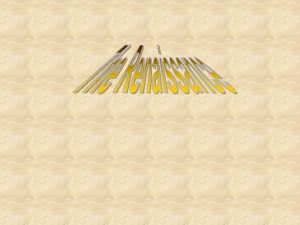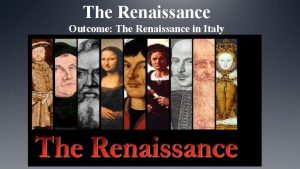Early Renaissance in Italy the fifteenth century quattrocento
















- Slides: 16

Early Renaissance in Italy: the fifteenth century quattrocento

RENAISSANCE Ø The word Renaissance means rebirth or revival (rinascimento , re-naissance) ü EARLY RENAISSANCE (ca 1400 – ca 1500) = “quattrocento” ü HIGH RENAISSANCE (ca 1500 – ca 1600) = “cinqecento”

Florence in the Early Renaissance Ø In the period, which we call the Early Renaissance, Florence is not a city in the unified country of Italy, as it is now. Instead, Italy was divided into many citystates (Florence, Milan, Venice etc. ), each with their own government Ø Political power in Florence was in the hands of middle-class merchants, a few wealthy families (such as the Medici, important art patrons who would later rule Florence) and the powerful guilds.

Why did the Renaissance begin in Florence? Ø Extraordinary wealth accumulated in Florence during this period among a growing middle and upper class of merchants and bankers. With the accumulation of wealth often comes a desire to use it to enjoy the pleasures of life.

Renaissance in art Ø Great revival of interest in the classical learning – when people of that period wanted to praise a poet or an artist, they said that his work was as good as that of the anciens (ancient Greece and Rome) Ø Humanism Ø Linear perspective Ø Dome in architecture Ø Central plan buildings Lorenzo Ghiberti, The story of Joseph, a panel from the second set of doors to the Baptistery, Florence chatedral

BRUNELESSCHI architect Ø The leader of the group of young Florentine artists was an architect FILIPPO BRUNELESSCHI Ø He was emloyed on the completion of the Cathedrale of Florence Ø He was inititator of the Renaissance architecture Ø He was an inventor of the perspective: illusion of depth in the painting

Santa Maria del Fiore – Cathedral of Florence – Il Duomo BRUNELESSCHI Ø It was a Gothic cathedral Ø Brunelesschi was influenced by Pantheon in Rome

https: //www. khanacademy. org/humanities/renaissance-reformation/earlyrenaissance 1/sculpture-architecture-florence/v/brunelleschi-dome-of-thecathedral-of-florence-1420 -36

Pazzi Chapel in Florence BRUNELESSCHI Ø Brunelesschi biult small church for the powerful family of the Pazzi in Florence Ø He has combined columns, pilasters and arches in his own way to achieve an effect of lightness and grace which is different from anything that had gone before https: //www. khanaca demy. org/humanities /renaissancereformation/earlyrenaissance 1/sculptu re-architectureflorence/v/brunellesc hi-pazzi-chapel-santa -croce-florencecompleted-1460 s

Invention of the linear perspective BRUNELESSCHI https: //www. khanacademy. org/humanities/renaissanc e-reformation/early-renaissance 1/beginnersrenaissance-florence/v/linear-perspective-brunelleschi -s-experiement Ø It was Brunelesschi who gave the artists the mathematical means of solving the problem Ø Perspective – illusion of depth in the painting Ø He used mathematical laws by which objects appear to diminish in size as they recede from us

Linear perspective MASACCIO painter The Holy Trinity with the Virgin and Saint John and donors, 1425. Fresco, 667 cm × 317 cm, Santa Maria Novella, Florence Ø Masaccio was the first painter in the Renaissance to incorporate Brunelleschi's discovery in his art. Ø Wall-painting which represents the Holy Trinity with the Virgin and St John under the cross, and the donors Ø He made a revolution in painting http: //www. artbabble. org/video/ngadc/empir e-eye-magic-illusion-trinity-masaccio-part-2

DONATELLO sculptor Ø The greatest sculptor of the early renaissance - quattrocento Ø His sculpture of St George standed in the niche on the outside of the Church of Or San Michele in Florence Ø Donatelo completely broke with the past (Gothic) how? ! St George. Marble statue from the Church of Or San Michele, Florence. About 1416. Florence, Bergello

DONATELLO Sculpture of St George, detail, Church of Or San Michele, Florence Ø Donatello’s St George stands firmly on the ground (no more reliefs like in Gothic art!) Ø His face had none of the serene beauty of medieval saints Ø Like the Greeks and Romans, Renaissance artists began to study the human body in their studios by asking models to pose for them in the required attitudes Ø Renaissance naturalism – new and vigorous observation of nature Notre-Dame de Chartres, Jesus Christ, Portal, Relief

DONATELLO Bronze sculpture of David Ø Donatello's bronze statue of David is famous as the first unsupported standing work of bronze cast during the Renaissance, and the first freestanding nude male sculpture made since antiquity https: //www. khanacademy. org/humanities/re naissance-reformation/earlyrenaissance 1/beginners-renaissanceflorence/v/contrapposto David. Bronze (1440 s? ) Museo Nazionale del Bargello. h. 158 cm

LORENZO GHIBERTI "Gates of Paradise" Ø In 1401, the sculptor Lorenzo Ghiberti won a major competition to design a new set of bronze doors for the Baptistery of the cathedral of Florence Ø They are recognized as a major masterpiece of the Early Renaissance Ø They were more naturalistic, with perspective and a greater idealization of the subject Ø https: //www. khanacademy. org/humanities/re naissance-reformation/earlyrenaissance 1/sculpture-architectureflorence/v/ghiberti-gates-paradise

Whatch this video https: //www. youtube. com/watch? v=w. L HBHA 0 s. Vg. E
 Chapter 12 the worlds of the fifteenth century
Chapter 12 the worlds of the fifteenth century Chapter 12 the worlds of the fifteenth century
Chapter 12 the worlds of the fifteenth century Causes of renaissance
Causes of renaissance The renaissance outcome the renaissance in italy
The renaissance outcome the renaissance in italy Human resource management 15th edition
Human resource management 15th edition University physics with modern physics fifteenth edition
University physics with modern physics fifteenth edition Fresh classical menu
Fresh classical menu What does rally round the flag mean
What does rally round the flag mean Management fifteenth edition
Management fifteenth edition Pretest: the early and mid-nineteenth century: romanticism
Pretest: the early and mid-nineteenth century: romanticism Unit 6 early 20th century ga
Unit 6 early 20th century ga Renacimiento quattrocento arquitectura
Renacimiento quattrocento arquitectura Quattrocento arquitectura
Quattrocento arquitectura Palacios renacentistas
Palacios renacentistas Giotto quattrocento
Giotto quattrocento Quattrocento secolo
Quattrocento secolo Italy: birthplace of the renaissance section 1 answers
Italy: birthplace of the renaissance section 1 answers
